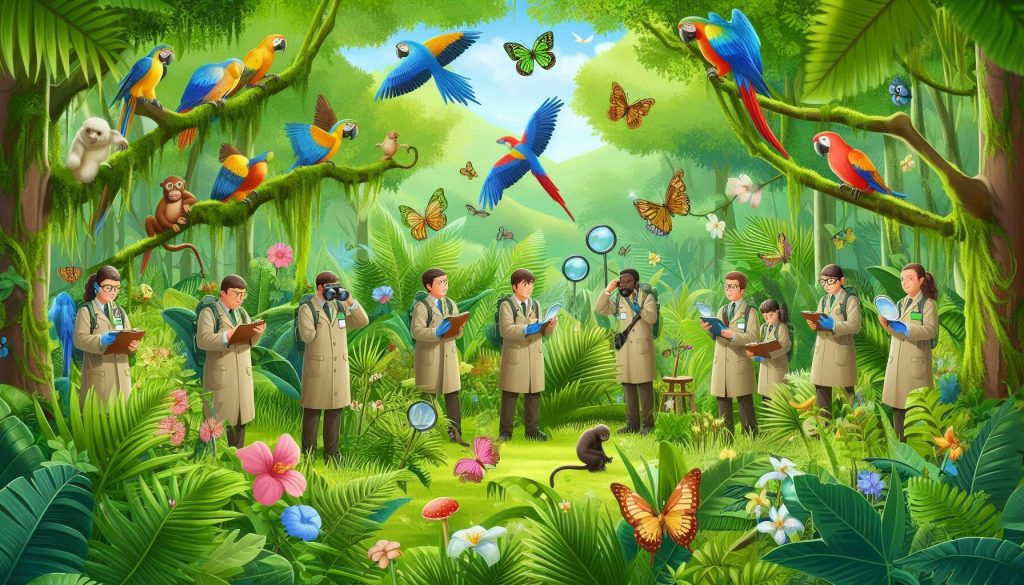Biodiversity and Conservation – Complete Guide For Class 11 Geography Chapter 14

Welcome to iPrep, your Learning Super App. Our learning resources for the chapter “Biodiversity and Conservation” in Geography for Class 11th are designed to ensure that you grasp this concept with clarity and perfection. Whether you’re studying for an upcoming exam or strengthening your concepts, our engaging animated videos, practice questions, and notes offer the best of integrated learning with interesting explanations and examples.
This chapter explores biodiversity, its importance, and the threats it faces. It delves into the different levels of biodiversity, its ecological, economic, and scientific roles, and the factors contributing to its loss. The chapter also discusses the urgent need for biodiversity conservation and the strategies employed to protect our planet’s precious natural resources.
Biodiversity, the variety of life on Earth, is essential for the health and well-being of our planet. It encompasses the diversity of genes, species, and ecosystems that interact to create the complex and interconnected web of life. However, biodiversity is under threat due to human activities, and its loss has severe consequences for ecosystems, economies, and human societies. This chapter will delve into the importance of biodiversity, the factors driving its loss, and the strategies for its conservation.
Objectives Of Learning the Chapter – Biodiversity and Conservation
Now that we have explored the importance of the chapter, let’s outline the objectives of studying it.
- To understand the concept of biodiversity and its different levels.
- To explore the ecological, economic, and scientific roles of biodiversity.
- To analyze the factors contributing to the loss of biodiversity.
- To discuss the importance of conserving biodiversity.
- To examine the strategies being employed to protect biodiversity.
Now let’s explore the various sections of the chapter.
Firstly, to understand genetic diversity, let’s delve into the section Genetic Diversity in the chapter “Biodiversity and Conservation.”
Genetic Diversity
Genetic diversity refers to the variation in genetic material within a species. It allows species to adapt to changing environmental conditions and increases their resilience.
Importance of Genetic Diversity:
- Enables species to survive environmental challenges.
- Prevents extinction by allowing adaptation.
- Essential for agricultural development.
Now, to understand species diversity, let’s explore the section Species Diversity in the chapter “Biodiversity and Conservation.”
Species Diversity
Species diversity refers to the variety of species within an ecosystem. A high species diversity indicates a healthy and resilient ecosystem.
Importance of Species Diversity:
- Maintains ecological balance.
- Provides resources like food, medicine, and raw materials.
- Supports ecosystem services, such as pollination and nutrient cycling.
Now, to gain a better understanding of ecosystem diversity, let’s look into the section Ecosystem Diversity of the chapter “Biodiversity and Conservation.”
Ecosystem Diversity
Ecosystem diversity refers to the variety of ecosystems within a region. It includes different habitats, such as forests, grasslands, wetlands, and marine environments.
Importance of Ecosystem Diversity:
- Ensures ecosystem services like clean water, fertile soil, and climate regulation.
- Supports human livelihood through agriculture, fisheries, and tourism.

Now, in order to understand the importance of biodiversity, let’s delve into the section Importance of Biodiversity in the chapter “Biodiversity and Conservation.”
Importance of Biodiversity
Biodiversity is essential for the health and functioning of our planet. It provides a range of benefits, including:
Ecological Role of Biodiversity
- Ecosystem stability: Biodiversity helps ecosystems to resist disturbances and recover from them.
- Nutrient cycling: Biodiversity plays a crucial role in nutrient cycling, which is essential for plant growth and soil health.
- Pollination: Many plants rely on pollinators, such as bees and butterflies, to reproduce.
- Pest control: Biodiversity can help to control pests and diseases.
Economic Role of Biodiversity
- Food security: Biodiversity provides a variety of food resources, ensuring food security.
- Medicines: Many medicines are derived from plants and animals.
- Tourism: Biodiversity attracts tourists, contributing to local economies.
Scientific Role of Biodiversity
- Scientific research: Biodiversity provides opportunities for scientific research and discovery.
Now, to understand the loss of biodiversity, let’s delve into the section Loss of Biodiversity of the chapter “Biodiversity and Conservation.”
Loss of Biodiversity
Biodiversity is declining at an alarming rate due to human activities, such as habitat destruction, pollution, overexploitation, and climate change.
Endangered Species
Endangered species are species that are at risk of extinction.

Vulnerable Species
Vulnerable species are species that are likely to become endangered shortly.
Rare Species
Rare species are species that have small populations.

Now, to understand how biodiversity can be conserved, let’s explore the section Conservation of Biodiversity in the chapter “Biodiversity and Conservation.”
Conservation of Biodiversity
Conservation of biodiversity involves protecting species, their habitats, and ecosystems. Conservation strategies include:
- In-situ conservation: Protecting biodiversity in its natural habitat, such as national parks and wildlife sanctuaries.
- Ex-situ conservation: Conserving biodiversity outside its natural habitat, such as zoos, seed banks, and botanical gardens.
- Legislation and Policies: Implementing laws and international agreements to prevent poaching, illegal trade, and habitat destruction.

Finally, as we have gained comprehensive knowledge about the chapter “Biodiversity and Conservation”, let’s reflect on the overall learning value of this important lesson.
Overall Learning Value of the Chapter
The chapter “Biodiversity and Conservation” emphasizes the importance of preserving biodiversity for ecological stability, economic prosperity, and scientific advancement. It highlights the critical role that various forms of life play in maintaining the balance of ecosystems. The chapter provides valuable insights into the causes of biodiversity loss and the urgent need for conservation efforts to protect endangered, vulnerable, and rare species. By understanding and acting upon this knowledge, students can contribute to the preservation of the natural world.
Let’s Conclude
In conclusion, the chapter “Biodiversity and Conservation” in Class 11th Geography has provided a comprehensive overview of the vital role biodiversity plays in our world and the critical need to conserve it. Through this chapter, students gain insights into the diverse types of biodiversity — genetic, species, and ecosystem — and understand why each is essential for ecological balance, economic value, and scientific progress. The chapter “Biodiversity and Conservation” also delves into the human-driven factors leading to biodiversity loss, such as habitat destruction and climate change, emphasizing the urgent need for conservation efforts.
Studying the chapter “Biodiversity and Conservation” equips students with knowledge about in-situ and ex-situ conservation strategies and fosters an appreciation for the laws and policies that safeguard natural resources. By mastering the concepts in this chapter, students are encouraged to think critically about their role in protecting our planet’s biodiversity. In this way, “Biodiversity and Conservation” empowers Class 11th students to be mindful stewards of the environment, fostering a future where natural diversity is preserved and valued.
Practice questions on Chapter 14 - Biodiversity and Conservation
Get your free Chapter 14 - Biodiversity and Conservation practice quiz of 20+ questions & detailed solutions
Practice Now








